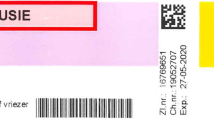Abstract
Confusion regarding a drug’s active ingredient may lead to simultaneous use of multiple acetaminophen-containing prescriptions and increase the risk of unintentional overdose. The objective of this study was to examine prescription labeling practices for commonly prescribed acetaminophen-containing analgesics, specifically focusing on how active ingredient information and concomitant use warnings were conveyed. Patients with new acetaminophen-containing prescriptions were recruited upon discharge from an emergency department in Chicago or at an outpatient, hospital-based pharmacy in Atlanta. Label information was transcribed from prescription bottles and patients’ knowledge of active ingredient was assessed by in-person interviews. Among the 245 acetaminophen-containing prescriptions, hydrocodone was the most common second active ingredient (n = 208, 84.8 %) followed by oxycodone (n = 28, 11.4 %). Acetaminophen was identified by its full name on 6.9 % (n = 17) of labels; various abbreviations were used in 93.1 % of cases. One hundred forty-seven bottles used auxiliary warning labels with the majority of labels (n = 130, 88.4 %) warning about maximum dose and 11.5 % (n = 17) about concomitant use. Most of the study participants (n = 177, 72.2 %) were not able to identify acetaminophen as an active ingredient in their prescription. There was no significant association between the use of unabbreviated labels including warning information and patients’ awareness of acetaminophen as an active ingredient (36.4 vs. 27.3 %, p = 0.50). We noted high variability in labeling practices and warning information conveyed to patients receiving acetaminophen-containing prescriptions. Missed opportunities to adequately convey risk information may contribute to the burden of acetaminophen-related liver injury.
Similar content being viewed by others
References
Bower WA, Johns M, Margolis HS, Williams IT, Bell BP (2007) Population-based surveillance for acute liver failure. Am J Gastroenterol 102(11):2459–2463. doi:10.1111/j.1572-0241.2007.01388.x
Larson AM, Polson J, Fontana RJ, Davern TJ, Lalani E, Hynan LS et al (2005) Acetaminophen-induced acute liver failure: results of a United States multicenter, prospective study. Hepatology 42(6):1364–1372. doi:10.1002/hep.20948
Ostapowicz G, Fontana RJ, Schiodt FV, Larson A, Davern TJ, Han SH et al (2002) Results of a prospective study of acute liver failure at 17 tertiary care centers in the United States. Ann Intern Med 137(12):947–954
Bond GR, Ho M, Woodward RW (2012) Trends in hepatic injury associated with unintentional overdose of paracetamol (acetaminophen) in products with and without opioid: an analysis using the National Poison Data System of the American Association of Poison Control Centers, 2000–7. Drug Saf 35(2):149–157. doi:10.2165/11595890-000000000-00000
Li C, Martin BC (2011) Trends in emergency department visits attributable to acetaminophen overdoses in the United States: 1993–2007. Pharmacoepidemiol Drug Saf 20(8):810–818. doi:10.1002/pds.2103
Manthripragada AD, Zhou EH, Budnitz DS, Lovegrove MC, Willy ME (2011) Characterization of acetaminophen overdose-related emergency department visits and hospitalizations in the United States. Pharmacoepidemiol Drug Saf 20(8):819–826. doi:10.1002/pds.2090
Osborne ZP, Bryant SM (2003) Patients discharged with a prescription for acetaminophen-containing narcotic analgesics do not receive appropriate written instructions. Am J Emerg Med 21(1):48–50. doi:10.1053/ajem.2003.50038
Fosnocht D, Taylor JR, Caravati EM (2008) Emergency department patient knowledge concerning acetaminophen (paracetamol) in over-the-counter and prescription analgesics. Emerg Med J : EMJ 25(4):213–216. doi:10.1136/emj.2007.053850
King JP, Davis TC, Bailey SC, Jacobson KL, Hedlund LA, Di Francesco L et al (2011) Developing consumer-centered, nonprescription drug labeling a study in acetaminophen. Am J Prev Med 40(6):593–598. doi:10.1016/j.amepre.2011.02.016
Wolf MS, King J, Jacobson K, Di Francesco L, Bailey SC, Mullen R et al (2012) Risk of unintentional overdose with non-prescription acetaminophen products. J Gen Intern Med. doi:10.1007/s11606-012-2096-3
Davis TC, Long SW, Jackson RH, Mayeaux EJ, George RB, Murphy PW et al (1993) Rapid estimate of adult literacy in medicine: a shortened screening instrument. Fam Med 25(6):391–395
American Association for Public Opinion Research (2004) Standard definitions: Final dispositions of case codes and outcome rates for surveys. American Association for Public Opinion Research, Ann Arbor, MI
National Council for Prescription Drug Programs. NCPDP recommendations for improved prescription container labels for medicines containing acetaminophen. 2013.
Lee WM (2007) Acetaminophen toxicity: changing perceptions on a social/medical issue. Hepatology 46(4):966–970. doi:10.1002/hep.21926
Funding
This project was funded by an investigator-initiated research grant from McNeil Consumer Healthcare.
Conflicts of Interest
Dr. McCarthy reported receiving grant funding from the Emergency Medicine Foundation/Purdue Pharma Pain and Prescription Management Grant. Dr. Parker reported receiving unrestricted research grant funding from McNeil Consumer Healthcare and Abbott Laboratories and having provided consultation services to Johnson & Johnson and McKing Consulting Corporation. Dr. Wolf reported receiving unrestricted research grant funding from McNeil Consumer Healthcare and Abbott Laboratories and having provided consultation services (health literacy, study design for comprehension testing for OTC & Rx product use) to McNeil Consumer Healthcare and Abbott Laboratories.
Author information
Authors and Affiliations
Corresponding author
Additional information
These data were presented in a poster at the Health Literacy Annual Research Conference (HARC) in Bethesda, MD on Oct 22, 2012.
Rights and permissions
About this article
Cite this article
King, J.P., McCarthy, D.M., Serper, M. et al. Variability in Acetaminophen Labeling Practices: a Missed Opportunity to Enhance Patient Safety. J. Med. Toxicol. 11, 410–414 (2015). https://doi.org/10.1007/s13181-015-0464-1
Published:
Issue Date:
DOI: https://doi.org/10.1007/s13181-015-0464-1




